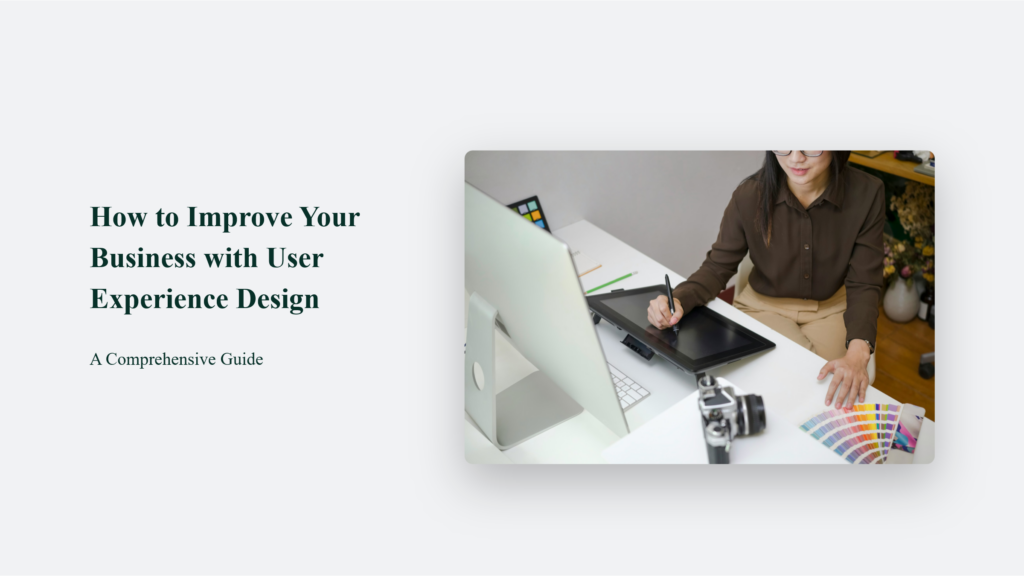

How to Improve Your Business with User Experience Design

As Seen On
In the bustling digital marketplace, user experience design emerges as a competitive edge and a fundamental necessity for businesses aiming to captivate and retain customers. With the right strategies, enhancing your UX design can significantly impact your business growth, user satisfaction, and, ultimately, your bottom line.

Key Takeaway: The Strategic Advantage of UX Design
Emphasizing UX design offers a strategic advantage by aligning your digital presence with user expectations and needs. Implementing the above strategies can enhance user satisfaction, increase loyalty, and increase conversion rates, thereby driving business success.
Introduction to User Experience Design
User experience design, at its core, focuses on the satisfaction and ease with which a user can interact with your website, app, or digital product. It encompasses everything from the initial design, layout, and content to the navigability, accessibility, and efficiency of the digital experience.
UX Design Principles: A Pillar of Success
Certain timeless UX design principles guide designers in creating interfaces that are not only visually appealing but also intuitively navigable and user-friendly. Among these is the importance of contextual, human-centred, findable, easy-to-use, and simple. Applying these principles ensures that users feel guided, understood, and valued throughout their digital journey.
Why User Experience Design is Crucial for Your Business
The significance of User Experience (UX) design in the business landscape has escalated dramatically, driven by its profound impact on user engagement, customer satisfaction, and conversion rates. This shift is not just a matter of improving aesthetic appeal or interface usability; it is fundamentally about enhancing the overall experience of the user, which, in turn, directly influences the success of a business in several key areas:
User Engagement:
A superior UX design ensures that users find it easier and more enjoyable to interact with a website or application. Businesses can significantly boost user engagement levels by streamlining navigation, optimizing page load times, and making the overall interaction more intuitive. Engaged users are likelier to spend more time on the site, explore various pages, and engage with the content, increasing the opportunities for conversions and sales.
Customer Satisfaction:
At its core, UX design meets the user’s needs and preferences, enhancing their satisfaction with the product or service. A positive user experience characterized by easy navigation, fast load times, and valuable content can increase customer satisfaction. Happy customers are more likely to become repeat customers and even brand advocates, sharing their positive experiences with others and thus attracting new customers.
Conversion Rates:
There’s a direct correlation between UX design and conversion rates. By optimizing the user experience, businesses can make it easier for visitors to find the information they’re looking for, interact with the site, and take desired actions, whether purchasing, signing up for a newsletter, or filling out a contact form. An intuitive and frictionless UX design can significantly reduce bounce and abandon rates, directly boosting conversions.
Search Engine Ranking:
Search engines, particularly Google, have begun to prioritize user experience as a key factor in their ranking algorithms. Mobile-friendliness, page speed, and user engagement metrics determine a website’s search engine ranking. By enhancing the UX design, businesses can improve these metrics, thereby improving their visibility in search results, attracting more organic traffic, and ultimately, driving more conversions.
Brand Reputation and Loyalty:
A well-designed UX can significantly enhance a brand’s reputation. Users will likely positively perceive brands that offer a seamless, efficient, and enjoyable online experience. This positive experience fosters customer loyalty, making them more likely to return to the site, use the service, or purchase the products again. In contrast, a poor user experience can damage a brand’s reputation and deter users from engaging with it in the future.
Examples of Effective UX Strategies
- Landing Pages Optimization: Ensure your landing pages make a great first impression and are designed around user needs for a seamless transition into your site.
- Use of Microcopy: The right words in the right place can significantly reduce user frustration and guide them towards desired actions.
- Embrace White Space: A clean, uncluttered layout using white space effectively can enhance user comprehension and engagement.
- Responsive Web Design: Given the variety of devices users browse on, a responsive design ensures a seamless experience across all screen sizes.
- Consistency Across Platforms: Maintain a consistent style and functionality across all user touchpoints to unify the user experience, similar to how Apple’s ecosystem operates.
The Bottom Line:
Incorporating user experience design into your business strategy isn’t just about aesthetics or trend-following; it’s about deeply understanding and fulfilling your users’ needs and preferences. By prioritizing UX, you enhance user satisfaction and engagement and set your business on a path to sustainable growth and competitive differentiation.
Frequently Asked Questions:
How does UX design impact SEO?
Search engines consider UX elements like site speed, navigation, and mobile friendliness when ranking websites, making UX crucial for SEO.
Can small changes in UX design make a big difference?
Yes, even minor adjustments, such as optimizing button texts (microscopy) or improving page load times, can significantly impact user satisfaction and conversion rates.
How often should I update my UX design?
Continuous testing and iteration are key. Regularly gather user feedback and use tools like A/B testing to refine and update your UX design.
Gracie Jones
Up until working with Casey, we had only had poor to mediocre experiences outsourcing work to agencies. Casey & the team at CJ&CO are the exception to the rule.
Communication was beyond great, his understanding of our vision was phenomenal, and instead of needing babysitting like the other agencies we worked with, he was not only completely dependable but also gave us sound suggestions on how to get better results, at the risk of us not needing him for the initial job we requested (absolute gem).
This has truly been the first time we worked with someone outside of our business that quickly grasped our vision, and that I could completely forget about and would still deliver above expectations.
I honestly can’t wait to work in many more projects together!
Disclaimer
*The information this blog provides is for general informational purposes only and is not intended as financial or professional advice. The information may not reflect current developments and may be changed or updated without notice. Any opinions expressed on this blog are the author’s own and do not necessarily reflect the views of the author’s employer or any other organization. You should not act or rely on any information contained in this blog without first seeking the advice of a professional. No representation or warranty, express or implied, is made as to the accuracy or completeness of the information contained in this blog. The author and affiliated parties assume no liability for any errors or omissions.

